2003 CHEVROLET ASTRO garage door opener
[x] Cancel search: garage door openerPage 113 of 386
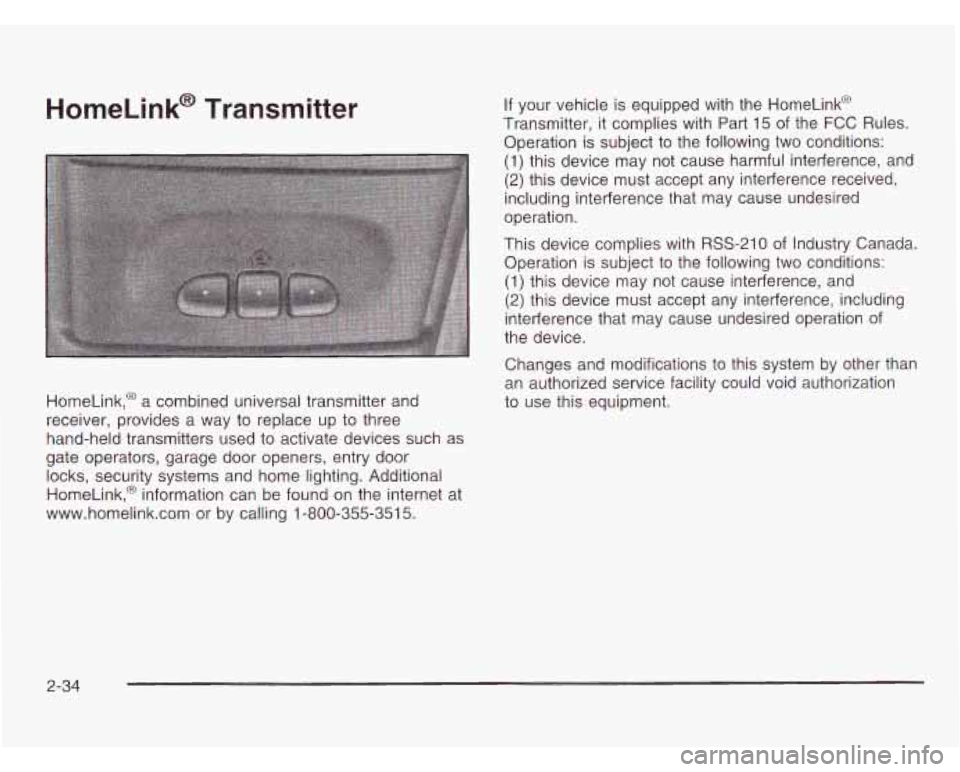
HomeLink@ Transmitter
HomeLink,@ a combined universal transmitter and
receiver, provides a way to replace up
to three
hand-held transmitters used
to activate devices such as
gate operators, garage door openers, entry door
locks, security systems and home lighting. Additional
HomeLink,@ information can be found on the internet at
www.homelink.com or by calling 1-800-355-351
5.
If your vehicle is equipped with the HomeLink@
Transmitter, it complies with Part 15 of the
FCC Rules.
Operation is subject to the following two conditions:
(1) this device may not cause harmful interference, and
(2) this device must accept any interference received,
including interference that may cause undesired
operation.
This device complies with RSS-210 of Industry Canada.
Operation is subject to the following two conditions:
(1) this device may not cause interference, and
(2) this device must accept any interference, including
interference that may cause undesired operation
of
the device.
Changes and modifications
to this system by other than
an authorized service facility could void authorization
to use this equipment.
2-34
Page 114 of 386
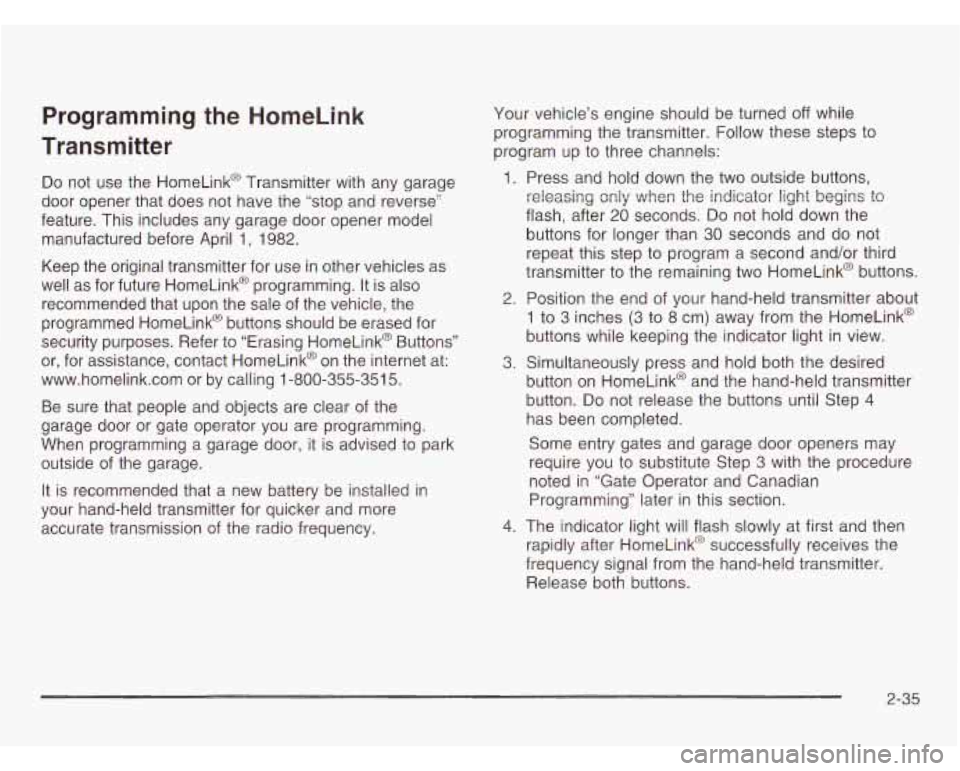
Programming the HomeLink
Transmitter
Do not use the HomeLink@ Transmitter with any garage
door opener that does not have the “stop and reverse”
feature. This includes any garage door opener model
manufactured before April
1, 1982.
Keep the original transmitter for use in other vehicles as
well as for future HomeLink@ programming. It is also
recommended that upon the sale of the vehicle, the
programmed HomeLink@ buttons should be erased for
security purposes. Refer to “Erasing HomeLink@ Buttons”
or, for assistance, contact HomeLinkO on the internet at:
www.home1ink.com or by calling 1-800-355-351 5.
Be sure that people and objects are clear of the
garage door or gate operator you are programming.
When programming a garage door, it is advised to park
outside of the garage.
It is recommended that a new battery be installed in
your hand-held transmitter for quicker and more
accurate transmission of the radio frequency. Your
vehicle’s engine should be turned
off while
programming the transmitter. Follow these steps
to
program up to three channels:
1. Press and hold down the two outside buttons,
releasing only when the indicator light begins
to
flash, after 20 seconds. Do not hold down the
buttons for longer than
30 seconds and do not
repeat this step
to program a second and/or third
transmitter to the remaining two HomeLink@ buttons.
2. Position the end of your hand-held transmitter about
1 to 3 inches (3 to 8 cm) away from the HomeLink@
buttons while keeping the indicator light in view.
3. Simultaneously press and hold both the desired
button on HomeLink@ and the hand-held transmitter
button.
Do not release the buttons until Step 4
has been completed.
Some entry gates and garage door openers may
require you to substitute Step 3 with the procedure
noted in “Gate Operator and Canadian
Programming’’ later in this section.
4. The indicator light will flash slowly at first and then
rapidly after HomeLink@ successfully receives the
frequency signal from the hand-held transmitter.
Release both buttons.
2-35
Page 115 of 386
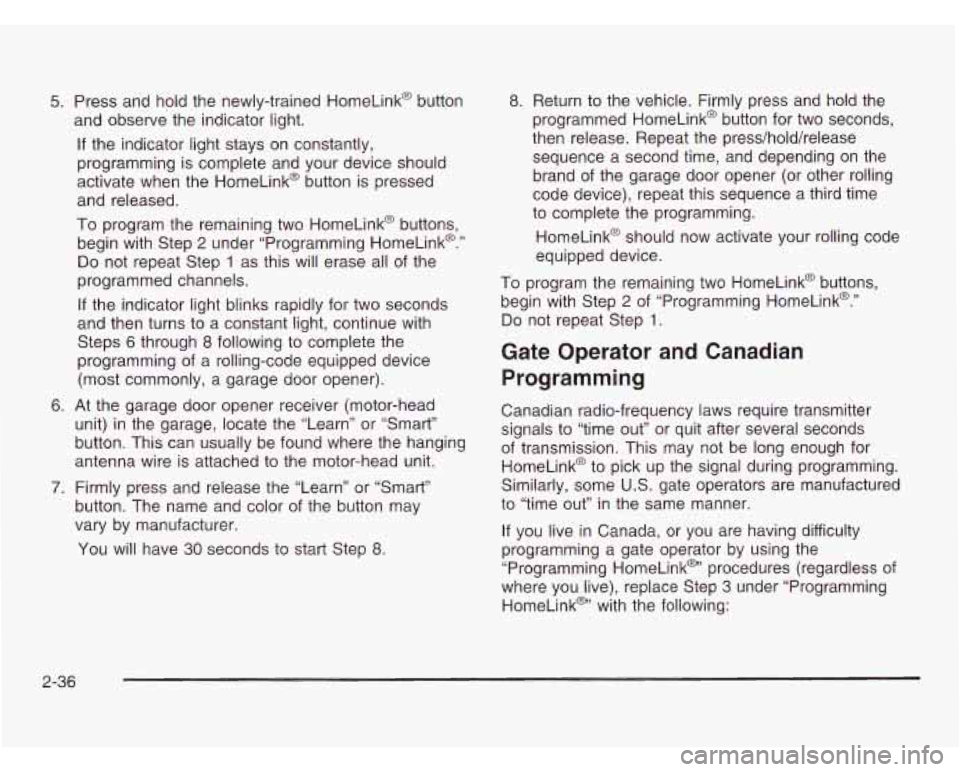
5. Press and hold the newly-trained HomeLink@ button
and observe the indicator light.
If the indicator light stays on constantly,
programming is complete and your device should
activate when the HomeLink@ button
is pressed
and released.
To program the remaining two HomeLink@ buttons,
begin with Step
2 under “Programming HomeLink@.”
Do not repeat Step 1 as this will erase all of the
programmed channels.
If the indicator light blinks rapidly for two seconds
and then turns to a constant light, continue with
Steps
6 through 8 following to complete the
programming of a rolling-code equipped device
(most commonly, a garage door opener).
6. At the garage door opener receiver (motor-head
unit) in the garage, locate the “Learn” or “Smart”
button. This can usually be found where the hanging
antenna wire is attached to the motor-head unit.
7. Firmly press and release the “Learn” or “Smart”
button. The name and color
of the button may
vary by manufacturer.
You will have 30 seconds to start Step 8. 8.
Return to the
vehicle. Firmly press and hold the
programmed HomeLink@ button for two seconds,
then release. Repeat the press/hold/release
sequence a second time, and depending
on the
brand of the garage door opener (or other rolling
code device), repeat this sequence a third time
to complete the programming.
HomeLink@ should now activate your rolling code
equipped device.
To program the remaining two HomeLink@ buttons,
begin with Step
2 of “Programming HomeLink@.”
Do not repeat Step 1.
Gate Operator and Canadian
Programming
Canadian radio-frequency laws require transmitter
signals to “time out” or quit after several seconds
of transmission. This may not be long enough for
HomeLink@ to pick up the signal during programming.
Similarly, some
U.S. gate operators are manufactured
to “time out” in the same manner.
If you live in Canada, or you are having difficulty
programming a gate operator by using the
“Programming HomeLink@’ procedures (regardless
of
where you live), replace Step 3 under “Programming
HomeLink@’ with the following:
2-36
Page 118 of 386

There is also a mapktorage pocket on the passenger's
side of the engine cover console. Your
vehicle may have this feature.
The overhead console includes reading lamps,
a compartment for a garage door opener, a trip
computer, a temperature and compass display, and a
storage compartment for sunglasses.
The reading lamps, trip computer, temperature and
compass display will work when the ignition is in
RUN,
ACCESSORY or when Retained Accessory Power (RAP)
is active. See "Retained Accessory Power" under
lgnition
Positions on
page 2- 19.
2-39
Page 119 of 386
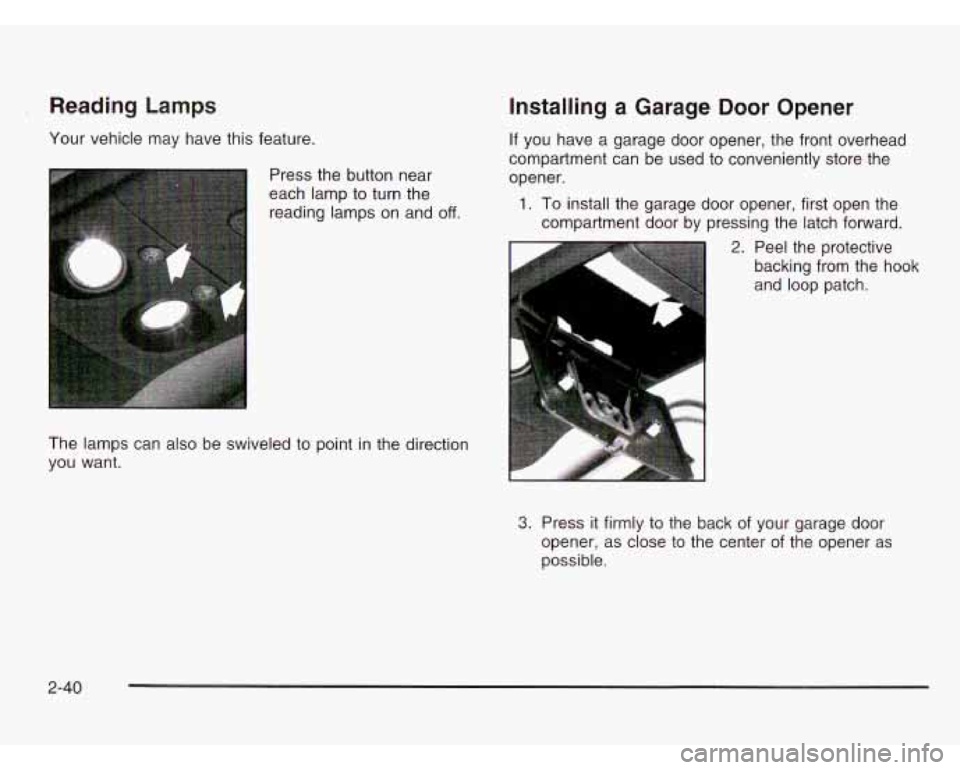
Reading Lamps
Your vehicle may have this feature.
Press the button near
each lamp to turn the
reading lamps on and
off.
The lamps can also be swiveled to point in the direction
you want.
Installing a Garage Door Opener
If you have a garage door opener, the front overhead
compartment can be used to conveniently store the
opener.
1. To install the garage door opener, first open the
compartment door by pressing the latch forward.
2. Peel the protective
and
loop patch.
b backing from the hook
3. Press it firmly to the back of your garage door
opener,
as close to the center of the opener as
possible.
2-40
Page 120 of 386
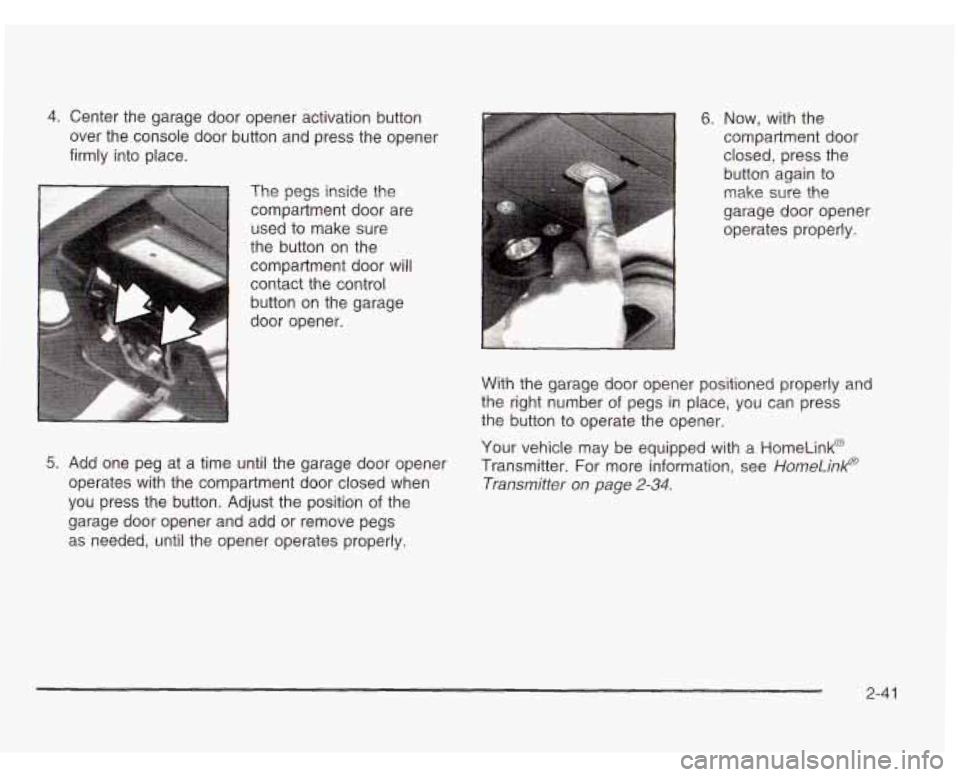
4. Center the garage door opener activation button
over the console door button and press the opener
firmly into place.
The pegs inside the compartment door are
used to make sure
the button on the compartment door will
contact the control button on the garage
door opener. 6. Now, with the
compartment door
5. Add one peg at a time until the garage door opener
operates with the compartment door closed when
you press the button. Adjust the position
of the
garage door opener and add or remove pegs
as needed, until the opener operates properly. closed,
press the
button again
to
make sure the
garage door opener
operates properly.
With the garage door opener positioned properly and
the right number of pegs in place, you can press
the button
to operate the opener.
Your vehicle may be equipped with a HomeLinkO
Transmitter. For more information, see
HomeLinP
Transmitter on page
2-34.
2-4 1
Page 372 of 386

Engine Coolant Level Check ............................. 6-26
Engine Oil Additives
........................................ 5-18
Entry Lighting
................................................. 3-15
Erasing HomeLink@ Buttons
.............................. 2-37
Except Cargo Vans
................................. 1-38, 1-47
Express-Down Window
.................................... 2-1 7
Extender, Safety Belt
....................................... 1-34
Exterior Lamps
............................................... 3-12
Engine
Oil Level Check
................................... 6-26
Exit Lighting
................................................... 3-15
F
FabricKarpet ................................................. 5-83
Filter Engine Air Cleaner
...................................... 5-24
Finding a Station
.................................... 3-39, 3-41
Finish Care
.................................................... 5-87
Finish Damage
............................................... 5-88
Fixed Mast Antenna
........................................ 3-50
Flash-to-Pass
................. ........................... 3-7
Flat Tire
........................................................ 5-70
Fluid Flat Tire, Changing
......................................... 5-71
Automatic Transmission
................................ 5-25
Power Steering
........................................... 5-40
Windshield Washer
...................................... 5-41
FM
............................................................... 3-50
Following Distance
.......................................... 4-38 Footnotes
..... ................................ 6.7.
6-18
Front Axle
........ ................................... 5-54
Front Doors
..................................................... 2-8
Fuel
............................................................... 5-5
Additives ...................................................... 5-6
California Fuel
.............................................. 5-6
Filling a Portable Fuel Container
.................... 5-10
Filling Your Tank
........................................... 5-8
Fuels in Foreign Countries
.............................. 5-7
Gage
......................................................... 3-36
Gasoline Octane
........................................... 5-5
Gasoline Specifications .................................. 5-5
System Inspection
....................................... 6-30
Fuel Regulator
................................................ 2-21
Fuses Low Warning
Light
....................................... 3-37
Fuses and Circuit Breakers
........................... 5-93
Windshield Wiper
......................................... 5-92
G
Gage
Check Gages Warning Light
.......................... 3-36
Engine Coolant Temperature
......................... 3-30
Fuel
.......................................................... 3-36
Oil Pressure
............................................... 3-34
Speedometer
.............................................. 3-25
Voltmeter Gage
........................................... 3-28
Garage Door Opener
....................................... 2-34
5
Page 374 of 386

Inspection (cont.) Exhaust System
........................ ....... 6-30
Fuel System
............................................... 6-30
Part C
- Periodic Maintenance ....................... 6-30
Steering, Suspension and Front Drive Axle
Boot and Seal
......................................... 6-30
Throttle System
........................................... 6-31
Installing a Garage Door Opener
....................... 2-40
Instrument Panel Cluster
....................................................... 3-24
Overview
.................................................. 3-2
Instrument Panel Brightness Control
.............. 3-1 5
Instrument Panel Fuse Block ............................ 5-93
Interior Lamps
................................................ 3-15
Interior Plastic Components
.............................. 5-85
Introduction Transfer Case (All-Wheel Drive) Inspection
........ 6-31
Jump Starting
....................................... ... 5-47
Key Lock Cylinders Service
.............................. 6-27
Keys
............................................................... 2-2
Keyless Entry System
....................................... 2-4
L
Lamps
Exterior
...................................................... 3-12
Interior
....................................................... 3-15
Lap Belt
........................................................ 1-27
Lap-Shoulder Belt
................................... 1-18, 1-29
LATCH System
Child Restraints
........................................... 1-52
Securing a Child Restraint Designed for
the LATCH System
........................... . 1-54
Latches, Seatback
............................................ 1-6
Leather
......................................................... 5-85
Leaving Your Vehicle
....................................... 2-10
Leaving Your Vehicle With the
Engine Running
.......................................... 2-28
Light
Air Bag Readiness
....................................... 3-26
Brake System Warning
................................. 3-28
Charging System
......................................... 3-27
Check Gages Warning
................................. 3-36
Low Fuel Warning
....................................... 3-37
Malfunction Indicator
.................................... 3-30
Safety Belt Reminder
................................... 3-26
Security
.............................................. 3-35
Service All-Wheel-Drive
......................... 3-35
Tow/Haul Mode
........................................... 3-36
Lamps On Reminder
....................................... 3-14
Anti-Lock Brake System Warning
................... 3-29
7